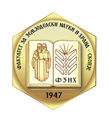YIELD OF BROOMCORN (SORGHUM VULGARE VAR. TECHNICUM [KÖRN.]) CULTIVATED IN SOUTHERN BULGARIA
Keywords:
broomcorn, Sorgum spp., Sorghum vulgare var. technicum [Körn.]), yield.Abstract
A three years’ comparative trial was conducted in Agricultural Experimental Station in the Eastern Rhodopes – Kardzhali, Bulgaria to assess the productive potential of five broomcorn genotypes – cultivar Prima and populations S14, G16, L18 and MI16N. Fresh biomass yield was formed by two to three cuttings per season, depending on annual precipitation quantities. The average duration for cutting formation for the region is from 35 to 45 days. When grown in Southern Bulgaria (Kardzhali region) broomcorn landraces can produced up to 9974 kg/da fresh biomass and up to 1977 kg/da dry mass, depending on the cultivation year. The highest yield of fresh and dry biomass was obtained from the local population MI16N, which exceeds the standard variety Prima from 131.8% to 185.1% and an average of 159.1%. This study demonstrates the potential of growing broomcorn for fodder in the conditions of Southern Bulgaria.



